Style Highlight: Kudo
Article by David B, June 2025
Since its inception in the 1960’s, Kyokushin Karate has gained notoriety as the “full contact” karate. Its founder, Masutatsu “Mas” Oyama, was a fascinating figure who deserves an article of his own. He promoted karate and built a worldwide empire. Kyokushin sparring can go very hard with heavy body shots and low kicks. Most notably, it does not permit punches to the face, but does allow kicks to the head, which has led to jaw-dropping compilations of tournament knockouts with spectacular kicks that rival Muay Thai in intensity and Tae Kwon Do in range and flexibility. Kyokushin fighters are very comfortable in the pocket, trading body blows and occasionally kicking at the head, sometimes committing their whole body weight into devastating kicks like do-mawashi kaiten-geri, 土回し回転蹴り, the “rolling thunder” kick.
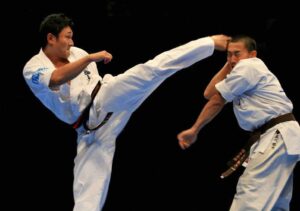
Kyokushin kumite is nearly full contact with minimal protective gear
Kyokushin is practiced in over 120 countries today, making it one of the most popular forms of Japanese karate, and is almost entirely responsible for the proliferation of the term “Osu” or “Oss” as an emphatic response, which is actually considered too rough to respond to a senior karateka in most Okinawan dojos (when in doubt, just say “hai!”)
How to Share With Just FriendsHow to share with just friends.
Posted by Facebook on Friday, December 5, 2014
But wait, this article isn’t about Kyokushin!

Takashi Azuma, the founder of Kudo Daidojuku
In the 1980’s, a 9th degree Kyokushin black belt who also held a 3rd degree black belt in Judo named Takashi Azuma (1931-2021) decided to bring the two martial arts together to overcome some of the things he didn’t like about Kyokushin kumite. As the wikipedia page for Kudo reads:
In 1981, Azuma founded his own martial art because he was unhappy with some characteristics of Kyokushin. He was bothered that in Kyokushin serious head injuries are common. Azuma was also of the opinion that physically smaller fighters are at a disadvantage compared to bigger fighters. Especially he had his own experiences of receiving so many nasty blows that his nose got bent out of its place. In his book, he quotes that he was “good at grabbing the collar and head-butting in a fight” and felt full-contact rules of Kyokushin very limiting.
Thus was born Kakutō Karate, 格闘空手, later known as Kūdō Daidojuku, 空道大道塾. It is a hybrid style with its own competition rules and protective gear. A relatively young martial art that incorporates elements of Karate, Boxing, Muay Thai, and Brazilian Jiu Jitsu, Kudo is written in Japanese as 空道; the name itself a combination of karate (空手) and judo (柔道). It was an early form of mixed martial arts that seems to translate well into self defense. With its broad toolbox, Kudo aimed to make competition fighting less “sporty” and better adapted to real-world combat. Focusing on conditioning and kumite alone, Kudo training involves stretches and exercises, kihon, shadow boxing, partner drills, and sparring with increasing levels of intensity, but abandons the practice of kata, which is usually a hallmark of traditional martial arts.
Protective Gear in Kūdō
The headgear is the standout feature of Kudo’s innovation, especially designed to provide good protection while allowing you to take heavy strikes without getting rocked. This addresses one of the few criticisms I’ve had of Kyokushin: the ruleset prohibiting punches to the head creates a bit of a blind spot: you don’t have to worry about punches to the head and are only paying attention to kicks as the greatest knockout threat, leading to a low and exposed guard at times. This becomes apparent when Kyokushin fighters square off with other styles, and flounder when they get punched in the face. Which reinforces my belief that how you train is how you fight, and how you fight is how you train.
The gloves in Kudo are very light–just a few ounces–with fingers free for grabbing and grappling, mainly designed to protect your hands when they hit the hard plate covering the face. There’s optional light protection on the shins and top of feet.
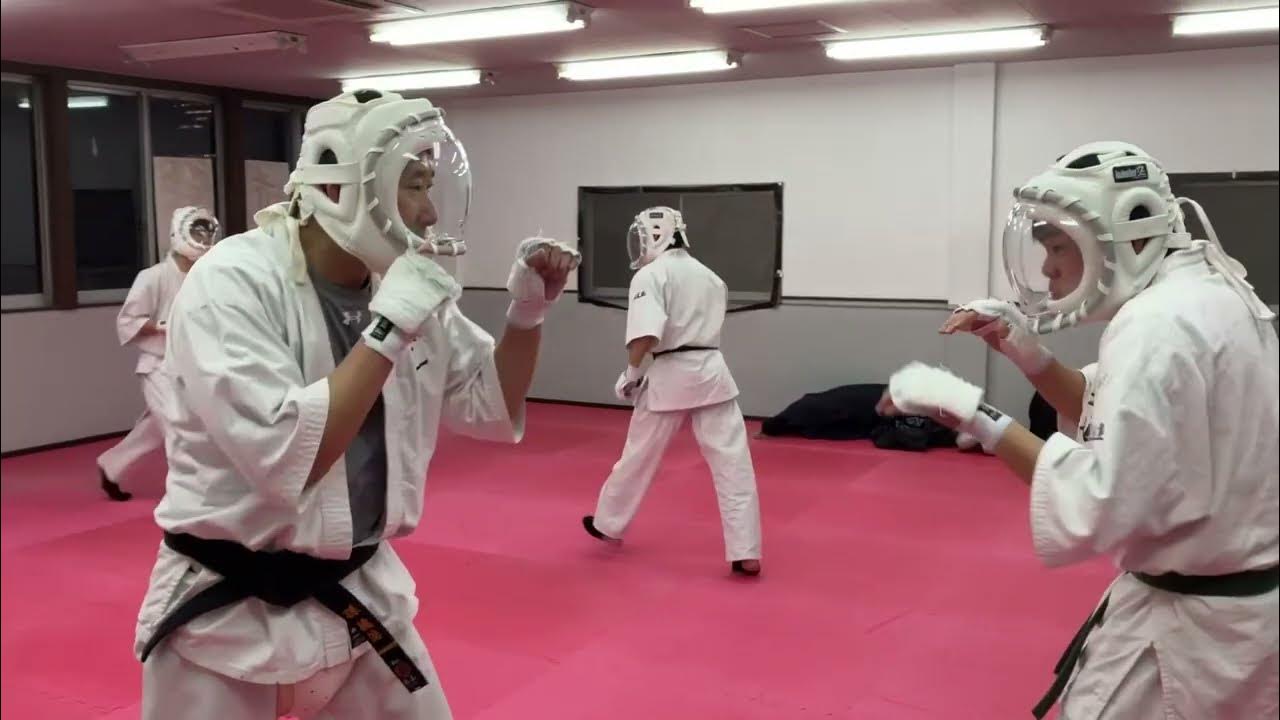
Watanabe sensei sparring with a student at his home dojo in Saitama, Japan.
Kudo re-introduces punches to the face while minimizing potential brain trauma injuries and CTE. As we read in “Fight Like a Physicist,” by Jason Thalken, Ph.D, the chin serves as a lever on the fulcrum of the neck, and striking it turns the neck, straining the axons in the brain and causing CTE (Chronic Traumatic Encephalopathy, a medical way to say brain damage) over time. One of the unique features of the kudo headgear is the full plexiglass faceplate that gently hugs the curve of the face into a well-padded chin, reducing this effect to provide better protection. This also opened up the possibility of headbutting, which is also permitted by Kudo rules. While many styles ostensibly teach headbutting techniques, Kudo and the Burmese style of Lethwei are the only two martial arts I’ve seen incorporate them into competition. Even groin shots are not off-limits, giving Kudo a tinge of dirty boxing that seems very practical for anyone who wants to train for situations where there’s no referee to stop your opponent from throwing such techniques.
Remember, there are no rules in a street fight, only consequences.
But it’s not just a striking sport, Kudo does something else that is unique amongst karate competitions: it incorporates and encourages clinching like Muay Thai, throws like Judo, and groundwork grappling like Jiu Jitsu. The dougi are also adopted from Judo, which favors a thick weave to withstand the abuse of grappling and gives the Kudo dojo the feel of a Kyokushin hall. The dougi also come in white and blue to provide contrast between fighters and make techniques easier for spectators to see. A rather realistic innovation was a time limit on grappling: after 30 seconds on the ground the fighters are stood back up. This both keeps the fight exciting and well-paced, and also brings a touch of realism, as you usually don’t get much more than 30 seconds of rolling around on the ground before someone might come up and starts pulling you off their friend, or kicking you in the head. The lesson is: if you’re going to take a fight to the ground, you need to be prepared to end it quickly.
My Experience with Kūdō Training
On a visit to Japan in 2023, I wanted to visit a Kudo gym, curious about its training style and especially its unique sparring gear. When I researched Azuma sensei a little, I learned that he was from Kesennuma, Miyagi prefecture and started the Kyokushin club at Waseda University. When I was at Waseda I joined a karate circle (Wadokai), though I hadn’t known about the Kyokushin club, perhaps fortunately; school clubs in Japan can be extremely intense and time-consuming, and I wasn’t ready for that level of commitment. I later did some volunteer work in Miyagi prefecture after the 3/11 Earthquake and Tsunami that devastated the East coast of Japan, and visited Kesennuma.
I had seen some videos made by Shihan Shinji Watanabe, a Kudo instructor in Saitama prefecture just north of Tokyo. I reached out to him and asked permission to come check out his dojo, and he gave me their training schedule to plan my visit.
As I stepped off the train, it rained on me for the first time my whole trip, and I had to get an umbrella on the way from Ōmiya station or risk getting soaked before a drop of sweat was shed. I met him at the 7-11 next to the dojo, and he led me upstairs to a generous space with puzzle mat floors and mirrors behind some standard weight training equipment. He cracked open the windows overlooking the street to let in the cool evening air. His students filtered in, we bowed in and got to work.
Kudo Warmups and Kihon
The videos below are of Azuma sensei explaining the basic training we warmed up with. The captions have errors in them and so some of the AI narration is mangled, but it’s a good introduction to the standard toolbox of Kudo’s conditioning and standup game.
Next, we did some idō keiko, movement training. This is familiar for most karateka who have done kihon up and down the dojo. The focus is on applying the technique while your weight shifts, and making the most of your body’s movement to increase the power in your strikes. The intensity was high, making the advancement very aggressive and confident, to flurry or overwhelm your opponent. A confused opponent is a vulnerable one
Lastly, we did several rounds of shadow boxing, which I found a great opportunity to feel how weak my cardio game was.
After going over all that, we moved to the grappling, working on newaza (ground techniques) or the standing clinch. The first class focused on some basic mount escapes on the ground. It felt like a good hands-on way to practice a technique.
Photos from my Visit:
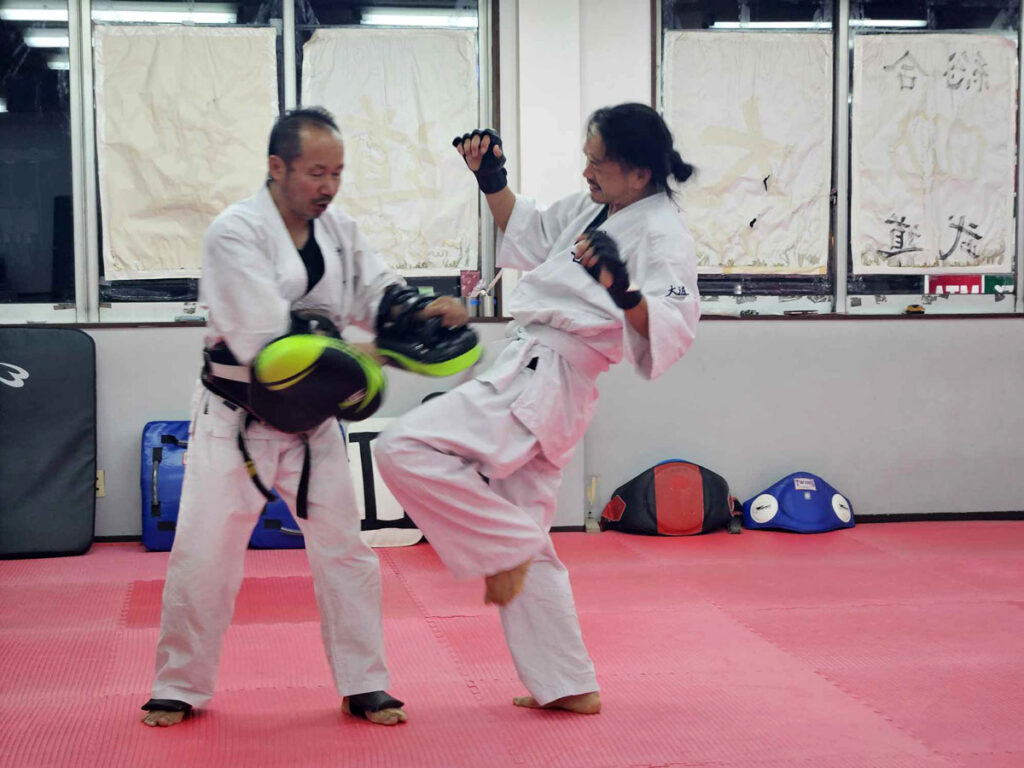
Fun Padwork
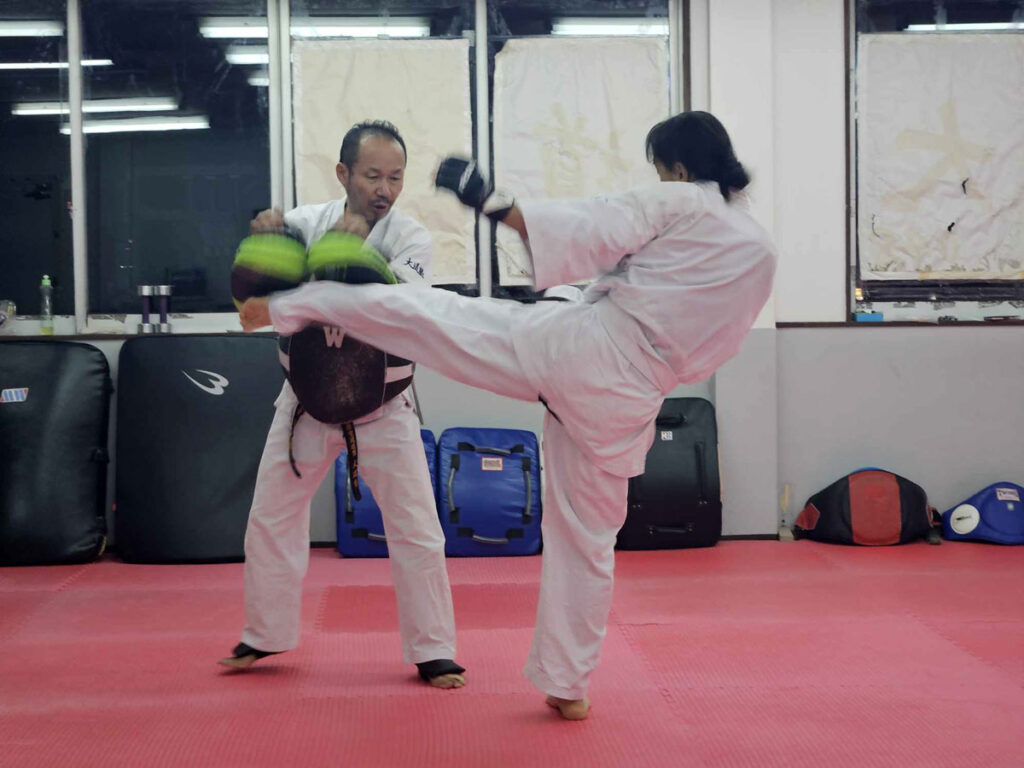
More Padwork
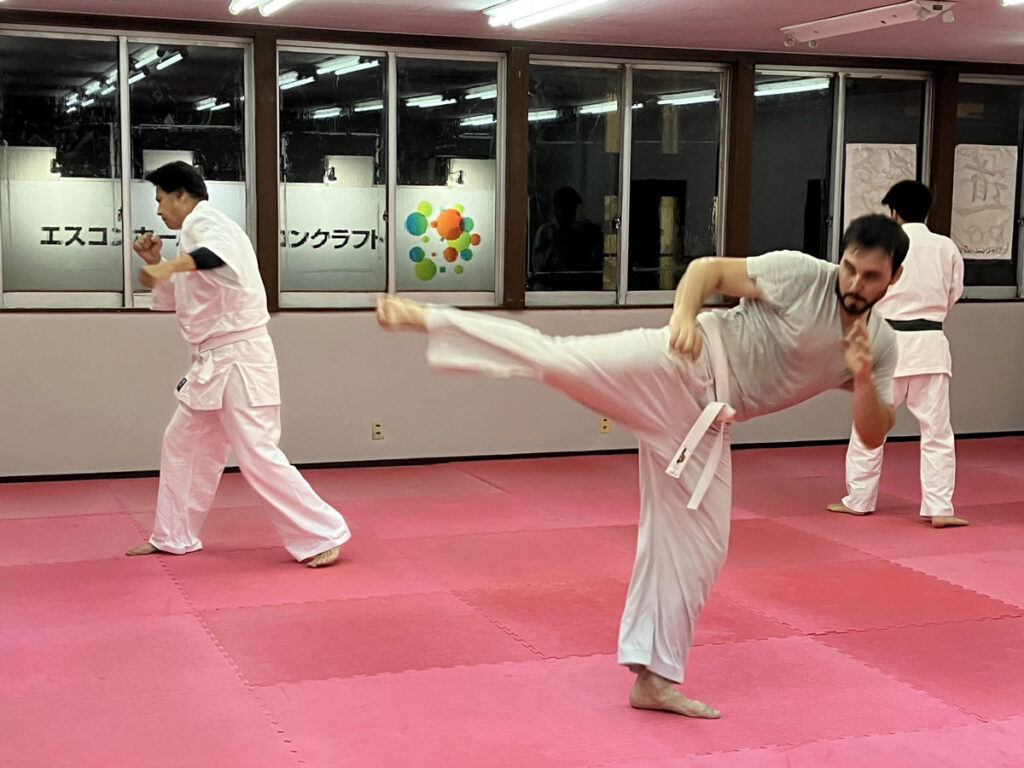
Shadowboxing
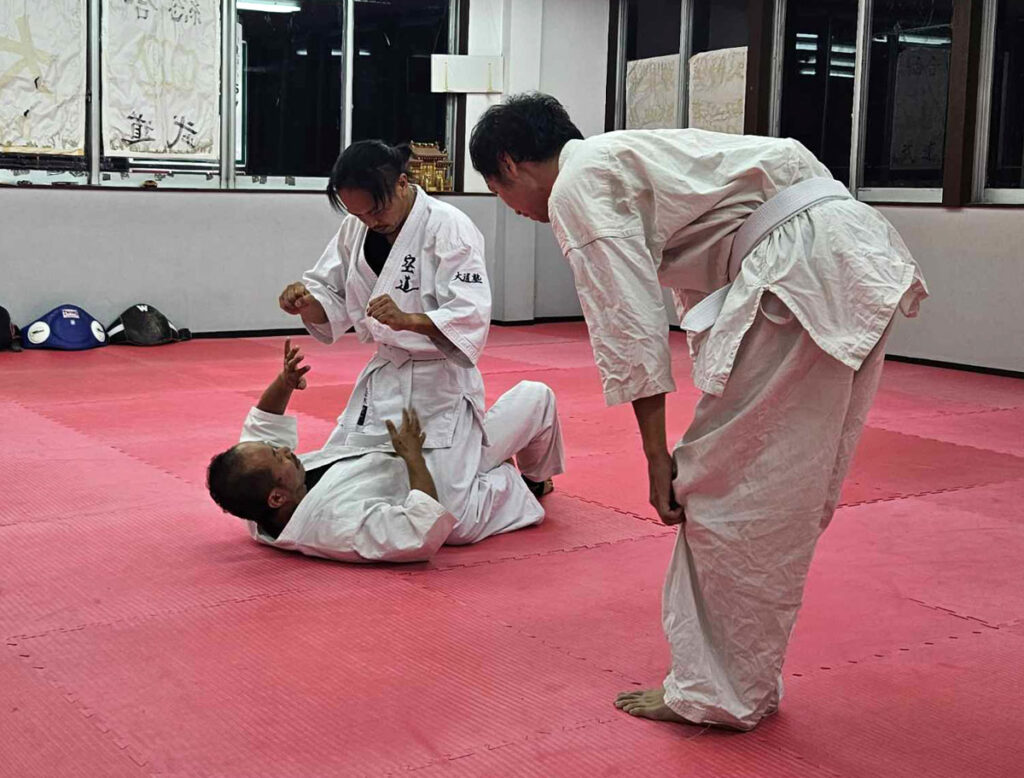
Teaching the escape from mount
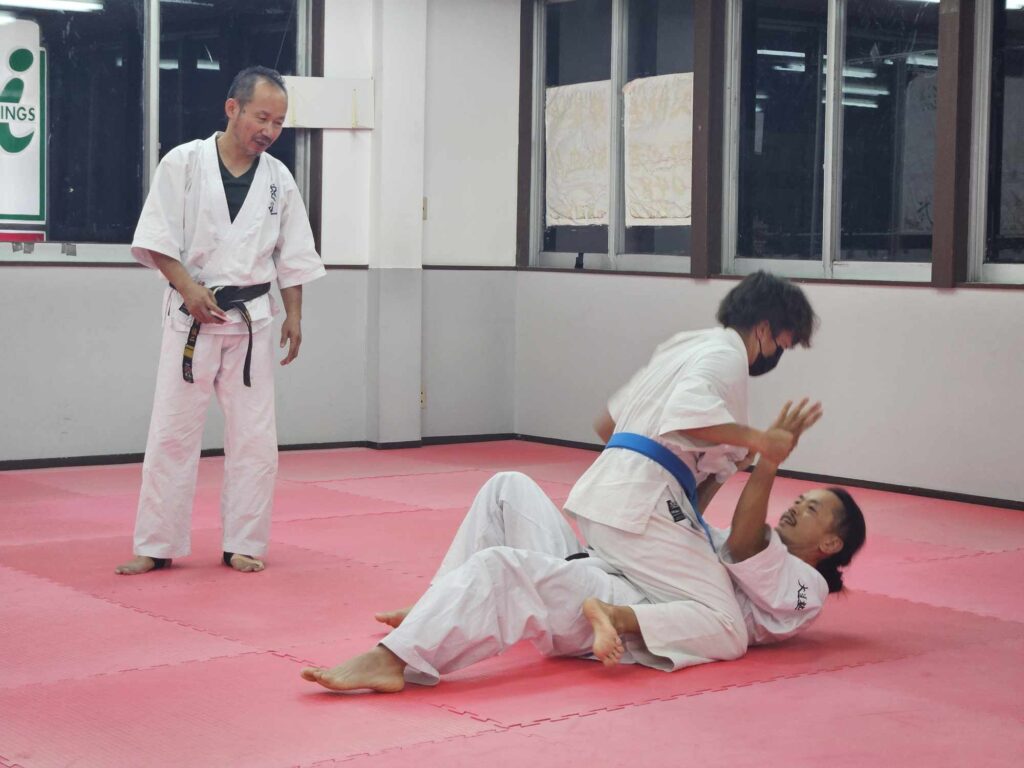
Drill Time

Flying Armbar?

One Serious
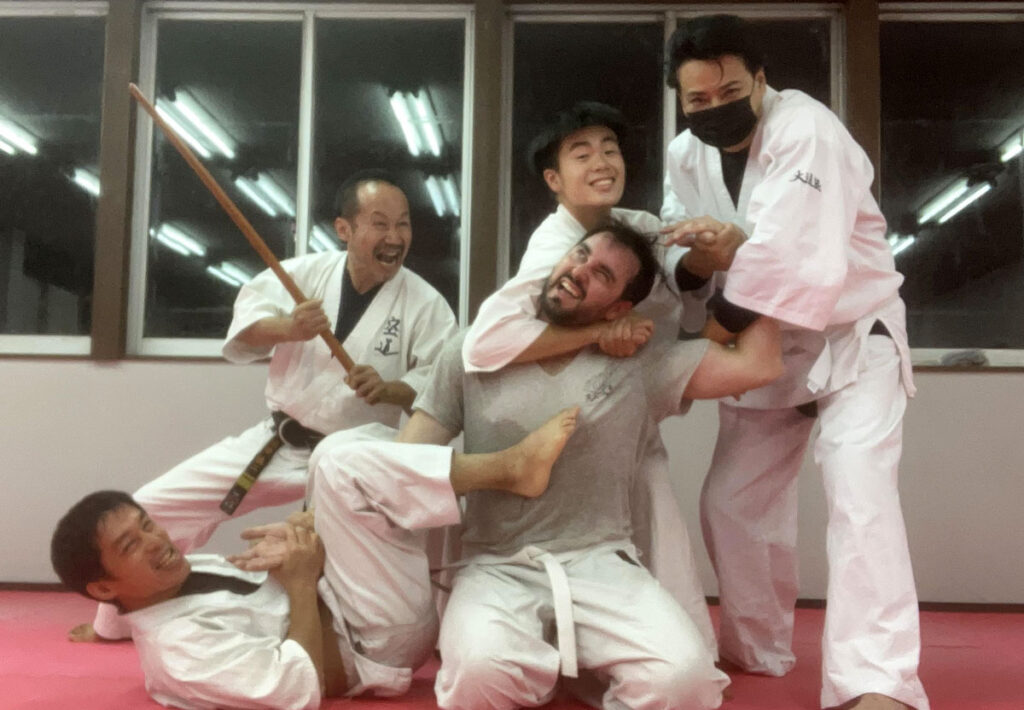
And One Silly
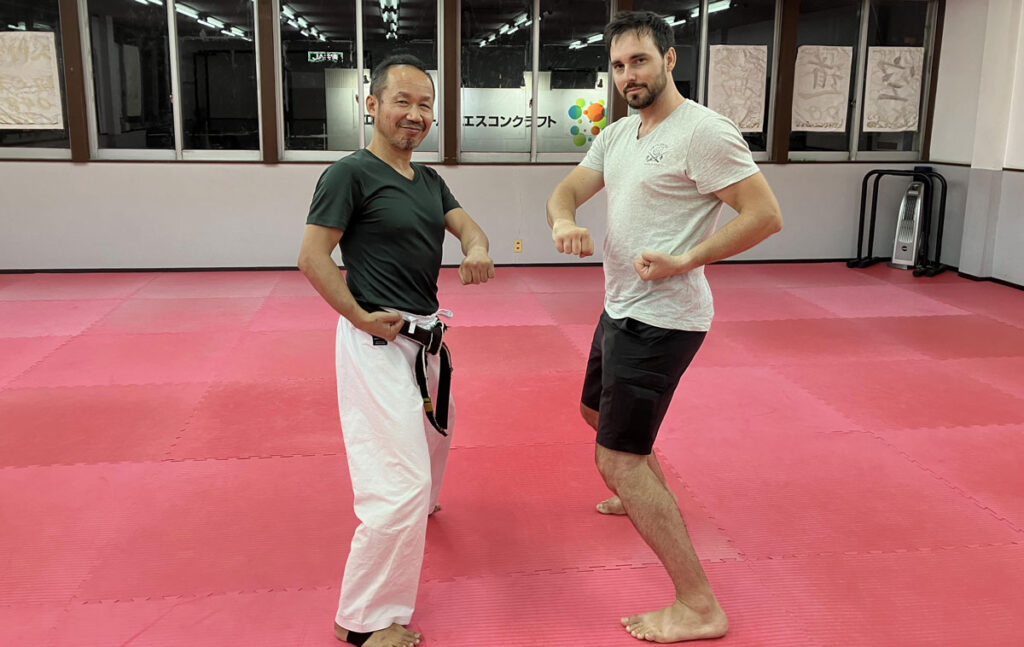
Watanabe Sensei and I enjoying some Naihanchi talk
Videos From My Visit
Kudo Drills
At the end of class a couple of the students did a few rounds of light sparring, starting with very light punches from a static stance, to boxing with movement, to including kicks, to including gentle takedowns. I really appreciated the gradual increase in temperature, a good way to teach students restraint and control, and to get gentle contact in a friendly environment.
Kudo Controlled Kumite
My Impressions of Kūdō
Due to the absence of kata, I don’t see Kudo as a karate style so much as a competitive approach to kumite with an expansive ruleset. Almost all of the training is concentrated on conditioning and techniques specifically for application in kumite, making it one of the most impressive pressure-tested styles wearing a dougi. Kudo feels like a supplemental and complementary training to the Shorin-ryu we practice at the Koyasan. With its focus on basic, effective techniques, emphasis on physical fitness and good cardio, I think it’s a great candidate for cross-training without affecting our own style’s lineage.
After two days I couldn’t say how technical grappling gets in Kudo compared to an all-grappling art like BJJ, but you don’t necessarily need 10,000 moves, but a handful of moves you’ve practiced 10,000 times. Overall, I am still fascinated by Kudo, and wish there were a local club to train with so I can get a better taste for the sparring.
Watanabe sensei was very welcoming and open, a trait shared amongst all the best karateka I’ve had the pleasure to meet. Although he is a dedicated and serious Kudo sensei, he also trains karate kata on his own, bringing back one traditional aspect of karate that is lacking in Kudo. Under the name Yuiga-ryu, He has done some deep introspection and personal reflection of kata and bunkai, and shared some interesting insights with me after the Kudo class had ended. Interestingly, although the Kyokushin katas take after Naha-te styles like Goju-ryu, Watanabe sensei is really fascinated by Naihanchi, the foundational kata of Shorin-ryu, and has published an entire video series about it. He made me think of Choki Motobu, an experienced fighter who went his own way, establishing Motobu-ryu, and spent much of his life plumbing the depths of Naihanchi.
I really wished I could have more time with him, so I made an effort to come back to the dojo on my way back from Utsunomiya a couple days later. Two days was just enough to barely whet my appetite.
Since I’ve come back stateside I found a Kudo helmet for sale, so I’m pretty much ready to go! It’s surprisingly comfortable, too. I used to dread it, but now I can’t wait to get kicked in the head!
I just don’t know if I’ll ever get used to saying “OSU!”


0 Comments